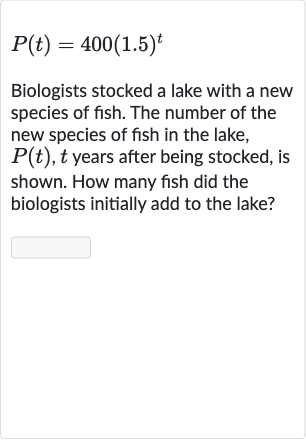Full solution
Q. Biologists stocked a lake with a new species of fish. The number of the new species of fish in the lake, years after being stocked, is shown. How many fish did the biologists initially add to the lake?
- Identify initial number of fish: Identify the initial number of fish. The initial number of fish is represented by the value of when , since represents the number of years after the fish were stocked.
- Substitute : Substitute into the equation to find the initial number of fish.Since any number raised to the power of is , we have:
- Calculate initial number: Calculate the initial number of fish.This means that the biologists initially added fish to the lake.
More problems from Write a linear function: word problems
QuestionGet tutor help
QuestionGet tutor help
QuestionGet tutor help
QuestionGet tutor help
QuestionGet tutor help
QuestionGet tutor help
QuestionGet tutor help
QuestionGet tutor help
QuestionGet tutor help

